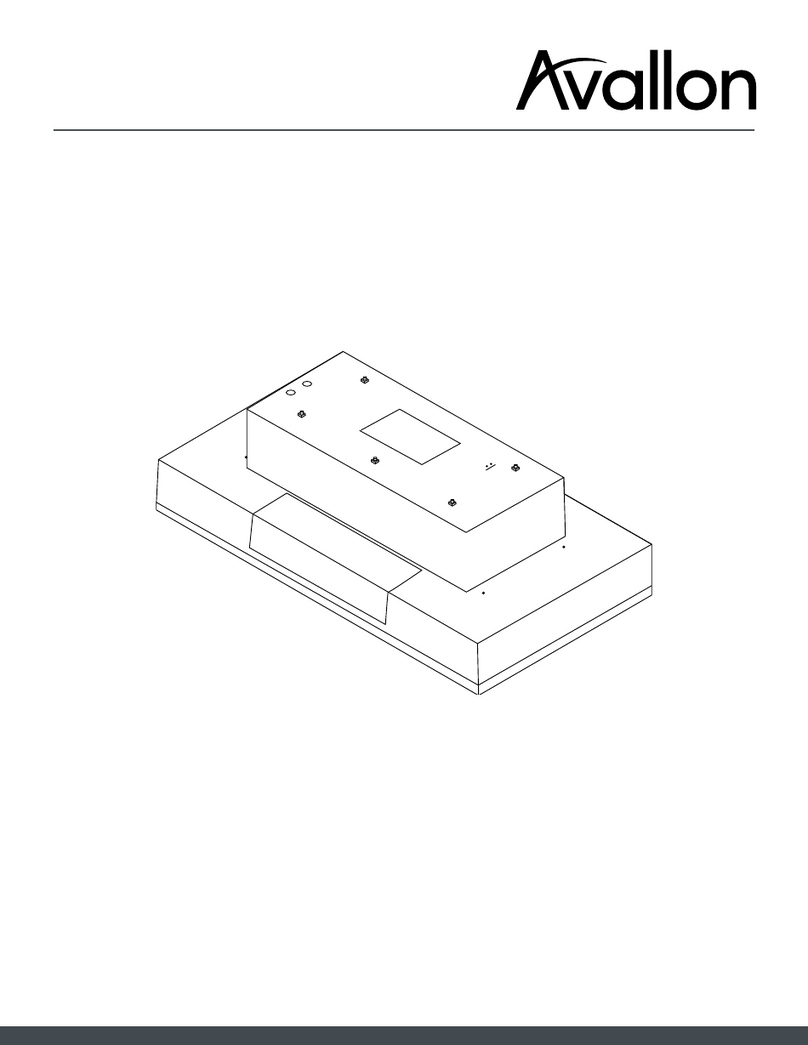
AVALLON.COM 2
®
Important Safety Information
Improper handling can cause serious damage to the Avallon range hood and / or injury to the user.
This range hood is designed for domestic indoor use only. Do not use the unit for industrial or
commercial use. Any other use may invalidate the warranty. Please review the rating label located
inside the hood under the baes for electrical and other technical data related to this unit. Please
read and follow the safety information listed below to reduce the risk of fire, electric shock, or injury.
IMPORTANT: Save these Instructions for the Local Electrical Inspector’s use.
INSTALLER: Please leave these Instructions with this unit for the owner.
OWNER: Please retain these instructions for future reference.
General Safety
WARNING: TO REDUCE THE RISK OF FIRE, ELECTRIC SHOCK, OR INJURY TO PERSONS, OBSERVE
THE FOLLOWING:
•Use this unit only in the manner intended by the manufacturer. If you have questions, contact
the manufacturer.
•Before servicing or cleaning unit, switch power off at service panel and lock the service
disconnecting means to prevent power from being switched on accidentally. When the service
disconnecting means cannot be locked, securely fasten a prominent warning device, such as a
tag, to the service panel.
CAUTION: FOR GENERAL VENTILATING USE ONLY. DO NOT USE TO EXHAUST HAZARDOUS
OR EXPLOSIVE MATERIALS AND VAPOURS.
WARNING: TO REDUCE THE RISK OF FIRE OR ELECTRICAL SHOCK,DO NOT USE THIS FAN WITH
ANY SOLID-STATE SPEED CONTROL DEVICE.
WARNING: TO REDUCE THE RISK OF A RANGE TOP GREASE FIRE:
•Never leave surface units unattended at high settings. Boilovers cause smoking and greasy
spillovers that may ignite. Heat oils slowly on low or medium settings.
•Always turn hood ON when cooking at high heat or when flambeing food (I.e. Crepes Suzette,
Cherries Jubilee, Peppercorn Beef Flambe’).
•Clean ventilating fans frequently. Grease should not be allowed to accumulate on fan or filter.
•Use proper pan size. Always use cookware appropriate for the size of the surface element.
WARNING: TO REDUCE THE RISK OF INJURY TO PERSONS IN THE EVENT OF A RANGE TOP
GREASE FIRE, OBSERVE THE FOLLOWING:
•Smother flames with a close-fitting lid, cookie sheet, or other metal tray, then turn off the
gas burner or the electric element. Be careful to prevent burns. If the flames do not go out
immediately, evacuate and call the fire department.
•Never pick up a flaming pan - you may be burned.
•Do not use water, including wet dishcloths or towels -a violent steam explosion will result.
•Use an extinguisher ONLY if:
–You know you have a class ABC extinguisher, and you already know how to operate it.
–The fire is small and contained in the area where it started.
–The fire department is being called.
–You can fight the fire with your back to an exit.




























